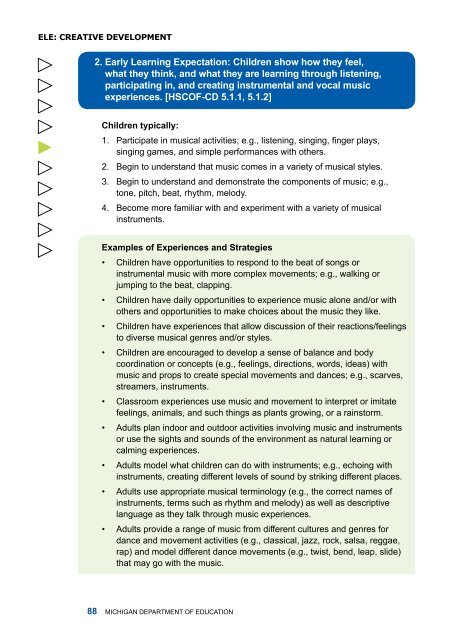Early Childhood Standards of Quality for ... - State of Michigan
Early Childhood Standards of Quality for ... - State of Michigan
Early Childhood Standards of Quality for ... - State of Michigan
Create successful ePaper yourself
Turn your PDF publications into a flip-book with our unique Google optimized e-Paper software.
ELE: Creative Development2. <strong>Early</strong> Learning Expectation: Children show how they feel,what they think, and what they are learning through listening,participating in, and creating instrumental and vocal musicexperiences. [HSCOF-CD 5.1.1, 5.1.2]Children typically:1. Participate in musical activities; e.g., listening, singing, finger plays,singing games, and simple per<strong>for</strong>mances with others.2. Begin to understand that music comes in a variety <strong>of</strong> musical styles.3. Begin to understand and demonstrate the components <strong>of</strong> music; e.g.,tone, pitch, beat, rhythm, melody.4. Become more familiar with and experiment with a variety <strong>of</strong> musicalinstruments.Examples <strong>of</strong> Experiences and Strategies• Children have opportunities to respond to the beat <strong>of</strong> songs orinstrumental music with more complex movements; e.g., walking orjumping to the beat, clapping.• Children have daily opportunities to experience music alone and/or withothers and opportunities to make choices about the music they like.• Children have experiences that allow discussion <strong>of</strong> their reactions/feelingsto diverse musical genres and/or styles.• Children are encouraged to develop a sense <strong>of</strong> balance and bodycoordination or concepts (e.g., feelings, directions, words, ideas) withmusic and props to create special movements and dances; e.g., scarves,streamers, instruments.• Classroom experiences use music and movement to interpret or imitatefeelings, animals, and such things as plants growing, or a rainstorm.• Adults plan indoor and outdoor activities involving music and instrumentsor use the sights and sounds <strong>of</strong> the environment as natural learning orcalming experiences.• Adults model what children can do with instruments; e.g., echoing withinstruments, creating different levels <strong>of</strong> sound by striking different places.• Adults use appropriate musical terminology (e.g., the correct names <strong>of</strong>instruments, terms such as rhythm and melody) as well as descriptivelanguage as they talk through music experiences.• Adults provide a range <strong>of</strong> music from different cultures and genres <strong>for</strong>dance and movement activities (e.g., classical, jazz, rock, salsa, reggae,rap) and model different dance movements (e.g., twist, bend, leap, slide)that may go with the music.88 <strong>Michigan</strong> Department <strong>of</strong> Education


